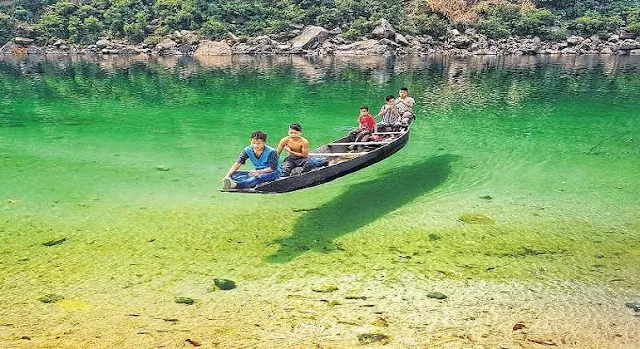Umngot River: A Testament to Indigenous Environmental Stewardship
Umngot River: A Testament to Indigenous Environmental Stewardship
The Umngot River, a jewel of Meghalaya, India, flows through the East Khasi Hills and West Jaintia Hills districts. This region, characterized by lush green landscapes and rolling hills, is part of the broader Meghalaya subtropical moist broadleaf forests ecoregion. The river itself is a tributary of the larger Brahmaputra River system, eventually draining into Bangladesh. While the exact length of the Umngot is not widely published, it is significant enough to support various ecological niches and provide essential resources to the local communities.
The river's clarity, often cited as a key characteristic, is attributed to several factors. The surrounding forests, largely undisturbed, act as natural filters, preventing soil erosion and sedimentation. The Khasi and Jaintia tribes' traditional practices, including controlled fishing and minimal interference with the river's flow, also contribute significantly to its pristine condition. They practice sustainable agriculture and avoid the use of harmful chemicals that could pollute the water.
The benefits and uses derived from the Umngot River are multifaceted:
Drinking Water: The river serves as a primary source of clean drinking water for the local communities. Its purity minimizes the need for extensive treatment, making it a vital resource.
Fishing: The river supports a variety of fish species, providing a source of livelihood and nutrition for the indigenous populations. Traditional fishing methods ensure the sustainability of fish stocks.
Irrigation: While not a major source of large-scale irrigation, the Umngot and its tributaries likely support small-scale agricultural activities in the region.
Tourism: The river's breathtaking beauty attracts tourists, generating income for local communities and raising awareness about the importance of environmental conservation. The Dawki bridge, a suspension bridge over the Umngot, is a popular tourist spot.
Ecosystem Support: The river supports a rich biodiversity, providing habitat for various aquatic and terrestrial species. Its health is crucial for the overall ecological balance of the region.
The Umngot River stands in stark contrast to some of India's other major rivers, such as the Ganga and Yamuna, which have suffered from pollution and degradation. Had these rivers been under the stewardship of indigenous communities with similar environmental ethics, their conditions might have been vastly different.
The story of the Umngot River highlights the invaluable contribution of indigenous people to environmental conservation. Their traditional wisdom, passed down through generations, offers valuable lessons in sustainable living and the importance of respecting nature's delicate balance.
In conclusion, the Umngot River serves as a powerful reminder of the vital role indigenous communities play in safeguarding our planet's natural resources. Their deep connection to the land and their commitment to sustainable practices make them true guardians of environmental purity and balanced living. Protecting this river and supporting the communities that sustain it is crucial for preserving this unique ecosystem and its cultural heritage.





Comments
Post a Comment